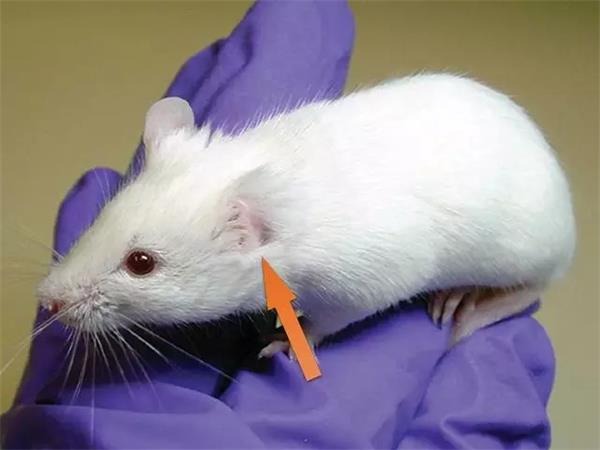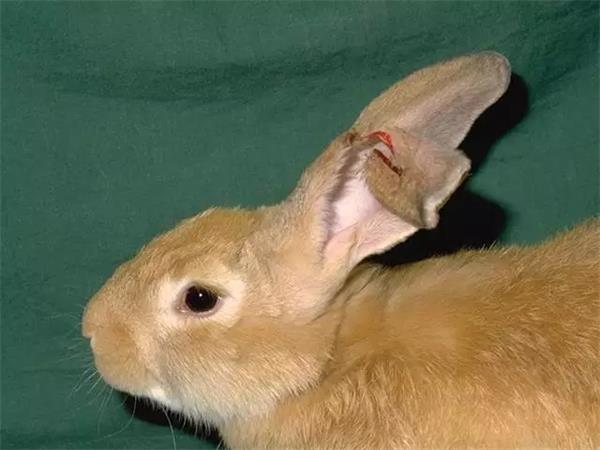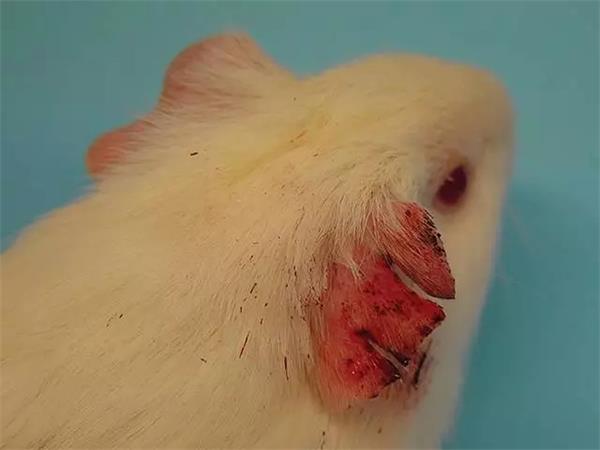Clinical observation of rodent experimental animals: abnormal clinical signs of animal signs (4)
§ Written in the front <br>The discovery of animal behavior or abnormal changes in the body is an important part of the daily work of experimental animal users. In your daily work, you have many opportunities to observe the normal performance and behavior of animals. When observing, the mind needs to know what is the normal performance of a particular group, a particular group or a particular type of animal. When we find that an animal behaves differently than normal, then the change can be called a clinical symptom because it may be a sign of a clinical (or visible) disease. Sneezing, dysentery or loss of appetite are also areas of clinical symptoms, and we can also refer to these abnormal changes as abnormal findings. This phase introduces you to the main part of the clinical symptoms of laboratory rodents ear. Figure 1 The mouse has one ear missing (as indicated by the arrow), which may be caused by genetic or early injury. Figure 2A The rabbit's ear is traumatized. Rabbit ear injuries may be caused by fights, ear tags, or improper administration through peripheral or central arteries (Image courtesy of LAVA, UK; ). Figure 2B The guinea pig ear trauma is caused by a fight. Ear secretions (crusted ears, pus in the ears) Reference material Iris Recognition Access Control Access Controller,Iris Recognition System,Iris Reader Access Control,Iris Recognition Access Control GRANDING TECHNOLOGY CO LTD , https://www.grandingsecurity.com
Small ears <br>Describe the ear of an animal is smaller than the ears of Other animals of the same age.
The cause may be caused by mutations, and mutual biting in the mouse or rat population may also result. 
Ear injuries (tearing ears, cauliflower ears, chewing ears, swollen ears, ear cartilage)
Describe the fragmentation of the animal's ear due to chewing, ear tags or tearing of the ear canal in other cages. For rats, the ears may show thickening and swelling. For mice, the edges of the ears may turn red, fester and even fall off. Rabbit ear movements and veins are often used for administration or blood collection. If there is a problem with the blood circulation in the ear, it may be hot when touched, then turn red and then turn black, and it may fall off in severe cases.
The cause of chewing the ear is a dominant behavior of the guinea pig, which may be learned from other animals. Fighting of rats and mice can also cause chewing ears. Frequent fights are a feature of some inbred mice (such as C57BL/6 mice, see the end of the article for details). In rabbits, ear trauma is usually caused by the administration of the ear and vein. Some rats may be caused by the body's reaction to the cartilage in the ear. Their ears are thickened and rugged, and they look like human "cauliflower ears." Ear tags can cause thickening of the ear cartilage, unevenness, holes in the ear, and infection. This condition may be related to neck and shoulder ulcers and may affect unilateral or bilateral ears. 

Describe the secretions or crusts in the ear of an animal.
The cause of the crust of the rabbit can especially indicate the presence of deafness, but it may also be caused by other causes. The crispy ear of a rodent may be due to an ear infection caused by an ear tag or trauma. Very few cases of infection in the ear can cause the secretion of the ear to flow out and stick to the coat. There is a gland (Zymbal's gland) just below the ear of the rat, which may be cancerous. In this case it looks a bit like ear secretions.
About the possible fighting phenomenon in C57BL/6 mice
1. Combativeness is the nature of C57BL/6 mice. Especially after male animals reach sexual maturity, their territorial awareness is enhanced. After long-distance transportation, feeding environment changes, experimental stress, etc., their fighting behavior may increase. And this feature is innate, there is no absolutely effective way to avoid it.
2. In order to reduce the phenomenon of mice fighting each other, you can try the following measures:
(1) When receiving animals, try to avoid dividing the animals in different transport boxes into the same cage when they are caged;
(2) When replacing the litter, you can take a little of the original waste padding on the surface of the new padding material to retain the original smell and try to use the original cage box; if you do not use the original cage box, it must The replaced cage box should be cleaned and thoroughly sterilized to reduce the irritation of the remaining odor;
(3) Minimize the stocking density of animals: If conditions permit, it is recommended to raise 2-3 per cage; in extreme cases, single cages are used for feeding;
(4) Observe the animals every day. On the one hand, if there is a fight in the cage, please pick out the strongest (no injury, complete beard), raise in a single cage, and use 75% of the injured individual daily. Alcohol or iodine disinfection, usually 5-7 days can be cured;
(5) Fix the personnel of the management as much as possible to reduce other factors that may cause stress;
(6) If possible, adding nesting materials (such as paper scraps) to the litter is also a good method. Because this nesting material can promote solidarity and cooperation between individual animals, thereby reducing the battle between each other.
3. The cleanliness of the feeding environment is also very important, remember to do regular disinfection work. Because only the environmental cleanliness is done, even if the mouse has a trauma after a fight, it is generally not infected.
§ More references These are just the "Icebergs" of Charles River Laboratories, "Handbook of Clinical Signs in Rodents and Rabbits." In recognition of the support of many customers in the life sciences industry for many years, from January 2016, Weitong Lihua has exclusively issued a limited edition Chinese version in mainland China, which will provide you with valuable experimental reference materials. The series is limited to the Chinese version of the limited edition, if you need the book, you can consult the regional manager in your area to get the internal publication.